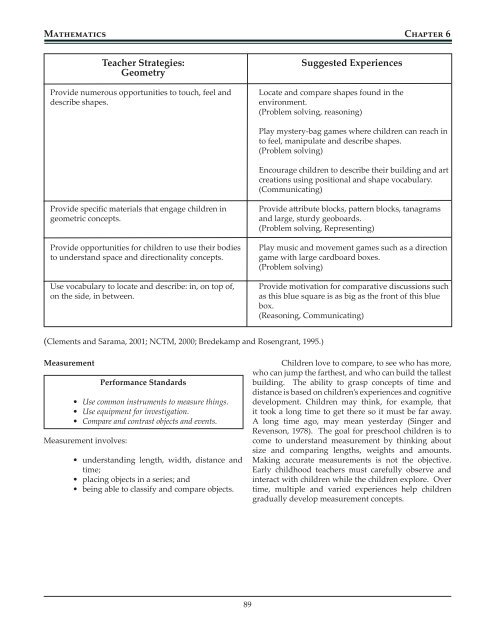Early Childhood - Connecticut State Department of Education
Early Childhood - Connecticut State Department of Education
Early Childhood - Connecticut State Department of Education
Create successful ePaper yourself
Turn your PDF publications into a flip-book with our unique Google optimized e-Paper software.
Mathematics Chapter 6<br />
Teacher Strategies:<br />
Geometry<br />
Provide numerous opportunities to touch, feel and<br />
describe shapes.<br />
Provide specific materials that engage children in<br />
geometric concepts.<br />
Provide opportunities for children to use their bodies<br />
to understand space and directionality concepts.<br />
Use vocabulary to locate and describe: in, on top <strong>of</strong>,<br />
on the side, in between.<br />
(Clements and Sarama, 2001; NCTM, 2000; Bredekamp and Rosengrant, 1995.)<br />
Measurement<br />
Performance Standards<br />
• Use common instruments to measure things.<br />
• Use equipment for investigation.<br />
• Compare and contrast objects and events.<br />
Measurement involves:<br />
• understanding length, width, distance and<br />
time;<br />
• placing objects in a series; and<br />
• being able to classify and compare objects.<br />
89<br />
Suggested Experiences<br />
Locate and compare shapes found in the<br />
environment.<br />
(Problem solving, reasoning)<br />
Play mystery-bag games where children can reach in<br />
to feel, manipulate and describe shapes.<br />
(Problem solving)<br />
Encourage children to describe their building and art<br />
creations using positional and shape vocabulary.<br />
(Communicating)<br />
Provide attribute blocks, pattern blocks, tanagrams<br />
and large, sturdy geoboards.<br />
(Problem solving, Representing)<br />
Play music and movement games such as a direction<br />
game with large cardboard boxes.<br />
(Problem solving)<br />
Provide motivation for comparative discussions such<br />
as this blue square is as big as the front <strong>of</strong> this blue<br />
box.<br />
(Reasoning, Communicating)<br />
Children love to compare, to see who has more,<br />
who can jump the farthest, and who can build the tallest<br />
building. The ability to grasp concepts <strong>of</strong> time and<br />
distance is based on children’s experiences and cognitive<br />
development. Children may think, for example, that<br />
it took a long time to get there so it must be far away.<br />
A long time ago, may mean yesterday (Singer and<br />
Revenson, 1978). The goal for preschool children is to<br />
come to understand measurement by thinking about<br />
size and comparing lengths, weights and amounts.<br />
Making accurate measurements is not the objective.<br />
<strong>Early</strong> childhood teachers must carefully observe and<br />
interact with children while the children explore. Over<br />
time, multiple and varied experiences help children<br />
gradually develop measurement concepts.

















